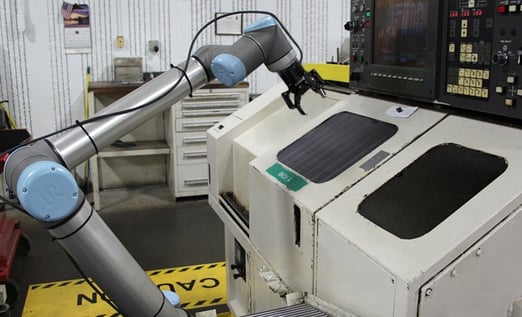How to Plan a Robotics Budget for 2017

How much should you invest in robots for your business this year? Here's how to start 2017 with a bang … and a robotics budget.
 I don't know about you, but around this time of year I start to think about budget. Specifically, I've been wondering: How much should invest back into my business in 2017?
I don't know about you, but around this time of year I start to think about budget. Specifically, I've been wondering: How much should invest back into my business in 2017?
Should I invest in new technology? Training courses? Outsourcing? Or do I need to knuckle down and become more efficient with the resources I already have?
Perhaps it's a symptom of the "New Year's Resolution bug" or perhaps it's because the financial year is fresh in my mind after doing last year's taxes. One thing is for sure, we can't invest in new technology without a solid business budget.
In this article, we show how to plan your robotics budget for 2017. This year is the perfect year to invest in robotics for your business! Here's how to start the year on the right foot.
Why We Need to Budget for Robotics
As you are no doubt well aware, budgeting is a core part of business. You can't purchase anything until you have checked that it aligns with your goals and finances. If your business is well established, budgeting ensures that the purchase contributes to your growth goals. On the other hand, if you are currently at the startup stage, budgeting is essential for your business to get off the ground.
Robotics budgeting is more goal-oriented than for a basic equipment purchase. Robots are often strongly aligned with a business's growth goals. Buying a robot has the potential boost your business, open up new customer bases and even change your company culture.
Set Robotics Goals for 2017
Before you write up your budget, it is a good idea to set your robotics goals for this year. We recently published an article about how to set robotics goals in 2017, which lays out a simple, 5-step process for doing this. Once your goals are clear, it will be much easier to make and justify budgeting decisions.

Make an Annual Budget
Work backwards from your goals to draw up a budget for your projected robotics purchases. You have probably implemented some sort of annual budgeting already in your business. Robotics can fall within your normal annual budget, but it might need a little bit of extra attention.
At the highest level, annual budgets consist of three main categories:
- Projected income for the year.
- Projected expenditure for the year.
- Interactions between the two (i.e. how expenses affect income and vice versa).
Within these, we usually have categories like: sales, salaries, supplies, equipment, insurance, rent, etc. Robotics relates to a few different costs, which are outlined below.
Because robotics is a technology investment, it is not always as straightforward as your basic overhead calculations. However, it has a lot in common with budgeting for IT or machine tools so there shouldn't be anything completely new.

Six Robotics Costs for Your Budget
Robotics technology is affected a variety of different costs. Here are six of the main ones:
- Equipment Costs — Equipment cost is an obvious category. One of our most useful posts from last year was What is an Average Price for a Collaborative Robot? which explains how to calculate the real cost of both industrial and collaborative robots. Don't forget that you will have to purchase more than just the robot itself. There are also add-on technologies to consider, like grippers and sensors.
- Staff — You may have to hire more staff to use the robots. Although this might not happen immediately, we have seen several companies hiring more workers due to the production increase caused by the robot.
- Robotics Training — Investment in robotic technology is often more complicated than other technology because it is combined with workforce training. Some robots need more training than others and you could also choose to outsource expertise. Either way, you may need to factor in some initial and ongoing training costs.
- Outsourcing — Robotic integrators are one option for integrating robots to your business. The costs and advantages are different from training in-house robotics experts. We compare the two options in our article In-house vs Outsourcing: How to Source Robotics Expertise.
- Depreciation — As with any technological investment, you also have depreciation to think about. One rough way to calculate the depreciation of a robot is to divide the initial investment by the projected life of the robot. For example, the minimum lifetime of a Universal Robot running at full speed with full payload is 35000 hours. At a cost of 35k USD, this means we can estimate that the robot will depreciate 1 USD per hour of operation — this is a very conservative estimate given that the robot will not always be running at maximum capacity.
- Maintenance, Upgrades and Replacement — Hand-in-hand with depreciation comes maintenance and upgrade. There are various maintenance considerations with robotics, including: robotic hardware maintenance, add-on technology maintenance, software upgrades, etc. Each of these will have a different time-frame. Eventually, the robot itself will need replaced. You can plan for this by estimating the robot's life based on your projected use. For example, with our 35000 hour Universal Robot, it could run for 4 years for 24 hours a day or 8 years for 12 hours a day.
When you have compiled your annual budget, have a look back at how much your business actually earned and spent in 2016. Check that it aligns with your projected robotics budget for this year. Is your projected growth realistic?
You will probably also find it useful to calculate the ROI of the robot, which you can do by using our downloadable ROI calculator.
The Challenge of a Changing Market
One of the main challenges of budgeting for robotics is that the marketplace seems to be changing so rapidly. If you read the Robotiq blog regularly, you will have seen many new robots turning up over the last couple of years. This can make it a bit of a headache to choose the right one. However, there is a simple solution.
If possible, assign a member of your team the job of monitoring the robotics industry. It's very useful to have one person who knows what your options are. A good place to find information about trends in the industry is via our list of 12 robotics blogs.
 How do you plan your robotics budgets? What investments will you make in robotics in 2017? How have your 2016 investments paid off? Tell us in the comments below or join the discussion on LinkedIn, Twitter, Facebook or the DoF professional robotics community.
How do you plan your robotics budgets? What investments will you make in robotics in 2017? How have your 2016 investments paid off? Tell us in the comments below or join the discussion on LinkedIn, Twitter, Facebook or the DoF professional robotics community.







Leave a comment